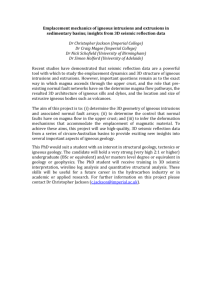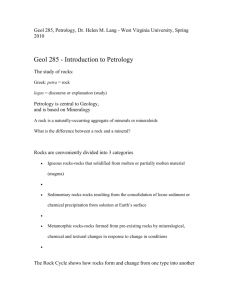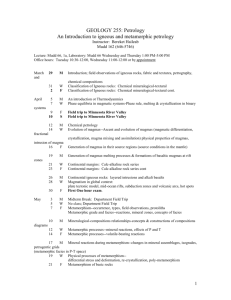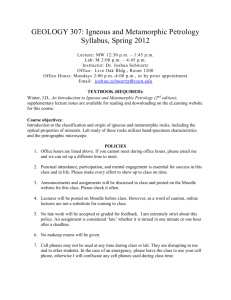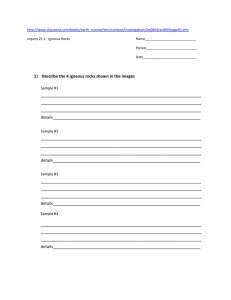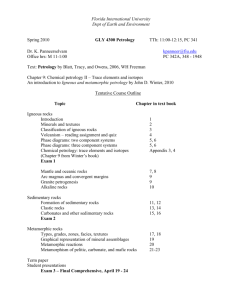4.2. Lecture notes etc.
advertisement
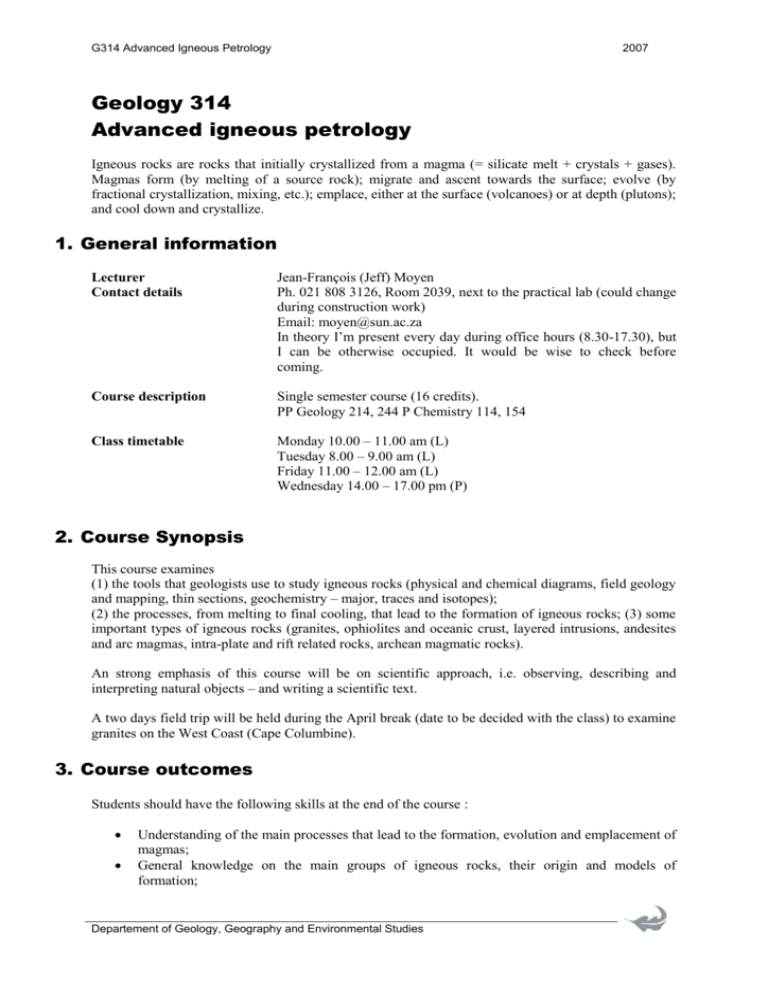
G314 Advanced Igneous Petrology 2007 Geology 314 Advanced igneous petrology Igneous rocks are rocks that initially crystallized from a magma (= silicate melt + crystals + gases). Magmas form (by melting of a source rock); migrate and ascent towards the surface; evolve (by fractional crystallization, mixing, etc.); emplace, either at the surface (volcanoes) or at depth (plutons); and cool down and crystallize. 1. General information Lecturer Contact details Jean-François (Jeff) Moyen Ph. 021 808 3126, Room 2039, next to the practical lab (could change during construction work) Email: moyen@sun.ac.za In theory I’m present every day during office hours (8.30-17.30), but I can be otherwise occupied. It would be wise to check before coming. Course description Single semester course (16 credits). PP Geology 214, 244 P Chemistry 114, 154 Class timetable Monday 10.00 – 11.00 am (L) Tuesday 8.00 – 9.00 am (L) Friday 11.00 – 12.00 am (L) Wednesday 14.00 – 17.00 pm (P) 2. Course Synopsis This course examines (1) the tools that geologists use to study igneous rocks (physical and chemical diagrams, field geology and mapping, thin sections, geochemistry – major, traces and isotopes); (2) the processes, from melting to final cooling, that lead to the formation of igneous rocks; (3) some important types of igneous rocks (granites, ophiolites and oceanic crust, layered intrusions, andesites and arc magmas, intra-plate and rift related rocks, archean magmatic rocks). An strong emphasis of this course will be on scientific approach, i.e. observing, describing and interpreting natural objects – and writing a scientific text. A two days field trip will be held during the April break (date to be decided with the class) to examine granites on the West Coast (Cape Columbine). 3. Course outcomes Students should have the following skills at the end of the course : Understanding of the main processes that lead to the formation, evolution and emplacement of magmas; General knowledge on the main groups of igneous rocks, their origin and models of formation; Departement of Geology, Geography and Environmental Studies G314 Advanced Igneous Petrology 2007 Understanding of the tools used to study igneous rocks (field observations, optical mineralogy, geochemistry, physical and chemical diagrams); Ability to describe igneous rocks at all scales (outcrop to analysis) and to provide at least some elements of interpretation, using basic tools and concepts; Ability to write the above as a structured, rigorous scientific text. 4. Study material and textbooks 4.1. Text book In addition to the reference books used for Geology 214 (that remain useful!), students should use the following book, that is one of the most up-to-date and comprehensive textbook in petrology: Winter, J.D. An introduction to igneous and metamorphic petrology. Prentice Hall, 2001. This book is rather expensive, but will also be used for Geology 354: metamorphic petrology. 4.2. Lecture notes etc. Slides used during the lectures, together with short lecture notes, will be available on the department’s web site, at http://academic.sun.ac.za/geology/undergraduate/modules/geol314_e.htm Last year’s lecture notes and slides should remain available throughout the year, so you can have access to the whole program. I’ll try to put the lecture notes (if not the slides) on the web in advance, before the lectures. It could be a good idea to browse through them in advance, which would allow to focus the formal lecture period on key points. 4.3. Other sources of information Students are encouraged to consult different text books and web sites, and to read as many journal articles as possible. 5. Assessment The final course mark is calculated from the course mark (40%) and the exam mark (60%). Normal university rules apply for rounding, second exams, etc. Marking for both the exam and the course will largely take into account student’s ability to conduct a scientific enquiry, from observations to conclusion, and expressing it as a rigorous, structured text. 5.1. Class mark The class mark is composed of (1) Continuous assessment of the practicals (12 pracs, 5% each); (2) Written report on the April field trip to the West Coast (20 %); (3) Individual presentation of a research paper, to be read and presented to the class (20 %). In case of absence due to proven illness or other bona fide reason, the final mark will be calculated on the remaining marks. Practicals are all marked and are personal, individual work (unless otherwise specified). Papers that are obviously copied from a book, a web source, or identical to other student’s work, will not be marked and the involved student(s) will get a zero mark for this practical. Repeated offenses will be dealt with according to the university plagiarism policy. Assignments are normally meant to be completed (or nearly so) during the practical period of Wednesday, but students have the option to take it home and work on it on their own time. However, I Departement of Geology, Geography and Environmental Studies G314 Advanced Igneous Petrology 2007 cannot guarantee that I will be available outside of lab hours, so it would be wise to do as much as possible at this time. There will be a few exceptions, mostly pracs that require the use of computers and cannot be done in the petrology lab. Assignments must be handed in at the latest during Monday’s lecture, giving me a fighting chance to look at them before the next practical session. Late assignments will not be marked, except by prior arrangement. A two-day field trip will be held during the April break, probably including some personal field exercise (mapping etc.) Students will hand in a short report on their work, the report mark will count towards the course mark. During the second part of the course, each student will select a research paper (among a list that I will propose), read it, understand it and present it to the class. Papers presentations are part of the course – i.e., topics covered in the papers will not be repeated during the lectures. Papers presentations will be marked and count towards the course mark. 5.2. Exam mark The final exam will be 3 hours long. It’s an open-book exam – all books, documents, course notes, etc. are allowed. The exam paper should include several short questions (8—10 questions), that will belong to two groups: (1) short, structured essays, requiring you to put together and summarize information from different sources (linking information from different chapters) (2) interpretation of data, documents, photos, maps, graphs, etc. 6. Field work A two-day field trip on the West Coast granites (Cape Columbine) is part of the course. This trip will be held during the April break, at a date convenient for everybody. We’ll be camping out one night in Cape Columbine Nature Reserve. During that trip, some key localities will be visited; in addition, students will probably do some individual work (such as mapping or interpreting one outcrop). Equipment and transportation will be provided by the department, food has to be arranged collectively. In addition, we’ll spend one of the prac sessions on the Cape Peninsula granitic pluton (probably in Sea Point). We’ll try to leave a bit earlier, and come back a bit latter, than the normal schedule, to be able to spend more time on the outcrop. Final date and arrangements for both will be decided with the students, to make sure that field work does not interfere with other activities. Please advice me as soon as possible of potential problems. 7. Class conduct etc. Lecture periods are times of interaction between the lecturer and the students. They are best used if students are prepared for the lectures (ideally, have read the relevant textbook chapter before), and are used for interactions and asking questions, rather than simply listening and taking notes. I’m considering moving part of the course to a more interactive format, in which students will be asked to read relevant material before coming to the course; the lecture period will be used for discussion etc. Students should feel free to discuss any problem concerning their progress in the course or their progress mark with the lecturer. Problems concerning the whole class should be brought to the lecturer by the class representative, who will discuss on behalf of the class. Finally – please make use of basic courtesy during lectures and prac sessions such as being on time (and well awake!), switching off your cell phone, etc. Departement of Geology, Geography and Environmental Studies G314 Advanced Igneous Petrology 2007 8. Provisional time table Subject to modifications, the course timetable should be as follows: In italics: relevant chapter(s) in Winter’s book. Week Date 1 Theme Introduction Chap. 1 5-9 feb 2 Chap. 2 and 8 1216 feb What's a rock is made of? Major and trace elements. Magmatic series Prac Lectures W1L1 1 W1L2 2 W1L3 3 W2L1 W2L2 4 5 W2L3 6 W3L1 7 3 Melting Chap. 5—7 and 10 1923 feb W3L2 8 W3L3 9 W4L1 10 Magma differenciation 4 Chap. 5—7 and 11 26 feb 2 mar How to identify magmatic processes? 5 Chap. 3--4 5-9 mar W4L2 11 W4L3 12 W5L1 13 W5L2 14 W5L3 15 Introduction to igneous petrology. Magmas from formation to emplacement Context: structure of the Earth Context: origin & differenciation of the Earth Geochemistry, analytical techniques. Interpreting geochemical data. Major elements. Magmatic series. Major elements (cont.): IUGS classification(s). Trace elements. Some useful representations Melting (1): Melting of the mantle and generation of basalts. Binary and ternary phase diagrams. Melting (2): Melting of the crust and generation of granites. Experimental petrology. Complex systems. Melting (3): Melt extraction & transport. Migmatites. Fractionnal crystallization(1): Phase relations and mineral formed. Gravitationnal settling. Fractionnal crystallization(2): Evolution of liquids. Descent lines. The meaning of magmatic series. Other differenciation processes. Liquid unmixing, mixing and assimilation. Cooling, solidification and textures of igneous rocks. Crystallization sequences. Zoning. Syn-tectonic textures Sub-solidus evolution. Secondary minerals. Fluid circulation, pegmatites and hydrothermal fluids. Mineral deposits. Greisens. Trace elements in igneous processes Departement of Geology, Geography and Environmental Studies IUGS classification CIPW norms Migmatites Building diagrams decided) phase (to be Crystallization sequence G314 Advanced Igneous Petrology Cooling and solidification 6 Chap. 8—9 12-16 mar Pluton emplacement 7 Chap. 4 19-23 mar Volcanoes 2007 W6L1 16 W6L2 17 W6L3 18 W7L1 19 W7L2 20 W7L2 21 W8L1 22 W8L2 23 W8L3 24 8 Chap. 4 26-30 mar Break Granites 9-13 apr 10 Chap. 13 16-20 apr 11 Chap. 12 23-27 apr Ophiolites Layered Igneous Complexes 12 Chap. 16—17 30 apr 4 may Sea Point Anatomy volcano of a Field trip to the West Coast. 2-6 apr 9 Chap. 18 Using geochemistry to distinguish between magmatic processes. Major, trace and isotopes. Isotopes(1): dating using isotopes. The U-Pb system. Concordia and discordia Isotopes(2): Using isotopes as tracers. Sr initial ratios. Isotopic heterogeneity of the Earth. Papers presentation: granite emplacement Pluton contact and other outcropscale features. Enclaves. Melt pathway. Magma movement and emplacement of plutons. Dykes and diapirs. Phreatomagmatism: magmawater interactions. Submarine volcanism, surtseyan eruptions, maars and diatremes. Volcanic processes linked to gas exsolution. Bubble nucleation and growth. Fragmentation. Plinian and katmaian eruptions, calderas. Gas-poor magmas. Lavas domes, block-and-ash flows, pelean eruptions. Lavas flows, hawaian and strombolian eruptions. Erosion and collapse of shield volcanoes. Arc magmas W9L1 25 W9L2 W10L1 26 27 W10L2 W10L3 28 29 W11L1 W11L2 W11L3 30 31 W12L1 W12L1 32 30 W12L2 33 Papers presentation - granites Granite genesis and evolution. Granites in a plate tectonics context. Papers presentation - ophiloites Ophiolites and the oceanic crust. Mid-ocean ridges. Papers presentation - LIC Layered igneous complexes. Origin of igneous layering. Papers presentation - intraplate Basaltic intraplate volcanoes. Oceanic islands, trapps. . Paper presentations - continental alkali Departement of Geology, Geography and Environmental Studies Granites Ophiolites LIC Alkali series G314 Advanced Igneous Petrology 13 Chap 14—15 and 19 14 7-11 may 14-18 may none Intra-plate magmatism Archean magmatism 2007 W13L1 34 W13L2 35 Continental alkali series. Potassic magmatism. Kimberlites; W13L3 36 W13L1 37 W13L2 38 Papers presentation - andesites Origin of andesites. Melting of the subduction-zone mantle. Source of fluids, melting reactions in presence of water. Continental arcs. Multicomponents magmatism. Papers presentations - Archaean magmatism W13L3 39 Archaean magmatism Andesites Archaean Notes: Due to other commitments, I will not be here during weeks 2 and 3. The course will be taught by G. Stevens during these two weeks. Logically, the trip to Sea Point belongs to week 7. But Wednesday of this week (21 March) is Human Right Day and is public holiday. However, if you were prepared to work on that day, we could go to Sea Point the 21st March, and leave another Wednesday free instead (the 7th March probably). We need to decide when the two-days field trip during the April break should be. Please think about any possible problems (other commitments, etc.); we’ll decide on a date as soon as possible. Departement of Geology, Geography and Environmental Studies


